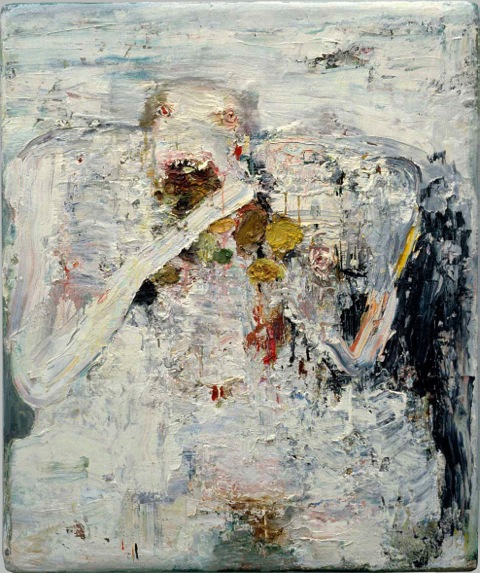
Self-Portrait 2. 48 x 40″. Oil on wood. 1994.
The first piece visible on entering Trembling Halves, a show of Brenda Goodman and Kate Gilmore at Tiger Strikes Asteroid in Philadelphia, is Goodman’s Self-Portrait 2, a mostly white, macabre painting of Goodman as a bloated figure masticating what could be any number of brownish, decadent, and disgusting substances. The surface is wrought, painted in a manner testifying to Goodman’s love of the medium. Every part of the piece is so thoroughly worked, the figure so built up on the surface, that it might as well be devouring burnt sienna itself rather than any kind of slop the color might try to signify. In some sense, cleverly situated as our introduction by curators Loren Britton and Zachary Keeting, it gives this warning: you are what you eat, and the menu’s all paint.
There is Goodman, of course, whose self portraiture is caked thick with it, but even Gilmore’s video pieces, Buster and Between a Hard Place, seem to take painting and its conventions as one of their central concerns. TSA being as small a space as it is, there’s no separate viewing space for video, so Britton and Keeting show them in tandem with Goodman’s paintings. As a result, the video becomes activated as painting, or a referendum on painting. Indeed, watching these videos is like seeing actual paintings transform into existence on the wall.
Buster shows Gilmore plowing methodically through clay vessels of white and purple paint, breaking them by stomping with soft sole shoes or by picking them up and smashing them against the floor. Arranged on descending stairs, their spilled contents create a vibrant drip pattern that puts the work in dialogue with the action painters of the height of modernism, who attempted to show a pure document of the passage of time through their painting. I think specifically, though, of Pat Steir, whose paintings, made by pouring fluid paint down the surface of a canvas, seem to capture time’s passage through one of its most beautiful, productive, and ancient referents — the erosion of earth by water, culminating in waterfalls. Time and action are of course implicit in a video piece, but that passage is emphasized in Buster’s goal-based, here-to-there progression.
Britton and Keeting take this idea in another fun direction with their decision to use a projector, and in so doing they can be seen to critique a particular problem of modernist theory that always bothered my overly concrete mind: that the flatness modernist painters held sacred was a kind of lie. No painting surface can be completely flat, and paint itself has dimensionality. The light of a projected image, perhaps, comes closer to that ideal. (Finding a perfectly flat ground, however, is a different story.)
But that’s all a secondary concern once we begin to consider Kate Gilmore herself, the artist and body. It seems so fitting to complicate a reexamination of modernist painting with the artist as destructor, plowing through obstacles, taking pain in stride. It’s appropriate particularly because Gilmore is a woman, playing with a genre so dominated by men, in which women have been historically overshadowed. The anonymous setting – grey descending bleachers – in some way makes Gilmore an everywoman for shattering precedent. We watch her in profile and are so taken by her quest that we become mixed up in it ourselves and feel her power in our own hands. Certainly, the works are nothing if not empowering. A woman complicates, and the gesture is extremely satisfying.
In another piece, Between a Hard Place, the materials change, though in essence a barrier in painting breaks again. The progression still runs here-to-there, but rather than a critique of modernism, it breaks through a much more ancient consideration of painting: the picture plane. The piece focuses on a series of drywalls through which Gilmore pounds with her fists and kicks with heavy heels. She takes no shortcuts and no breaks – the video is one long, continuous, evenly paced barging-through of four subsequent walls, deeper and deeper into a receding space.
Perhaps even more than Buster, Between a Hard Place makes the viewer consider the pain Gilmore must have endured in her progress. At one moment on the first wall, a row of nails sticks out from the gouged drywall, and almost as if presented with a challenge, Gilmore jams her hand right through it. It’s a cringe-worthy moment that manages to stand out amongst an especially cringe-heavy piece – look closely and you see what could very well be blood dripping from the nails – but there’s no reaction from Gilmore herself. She continues on at an even pace, breaking through three more frames.
The measured pace distances the viewer from Gilmore such that the physical pain she must feel becomes less a mirrored experience than a rationalized one. We come to understand Gilmore less as a body and more as an intellectual endeavor unfolding before us. In so doing, she undoes the kind of erotic play so common to women in illusionistic paintings, often at the mercy of men, objects of desire and a male gaze that historically has made them vessels of sexual experience. And with this methodical destruction of the picture plane, Gilmore asserts a bold female presence in what is otherwise a space where women have been traditionally fetishized. The framing of the video on an iPad is another clever touch on Britton and Keeting’s part, much like Buster’s projection. Light emanates into the space of the viewer as if from a window to another world, as illusionistic painting has often been conceptualized.
Beyond this critique is the pure endeavor itself; we can simply be in awe of Gilmore’s endurance, her tolerance for pain, her persistence. She is a juggernaut. Despite the distance she creates in her methodical onslaught – seemingly ultra-human – we always remember that she is mortal like the rest of us. But she represents a potential for brute strength and determination, played out in their simplest forms, that’s both entrancing and inspiring.
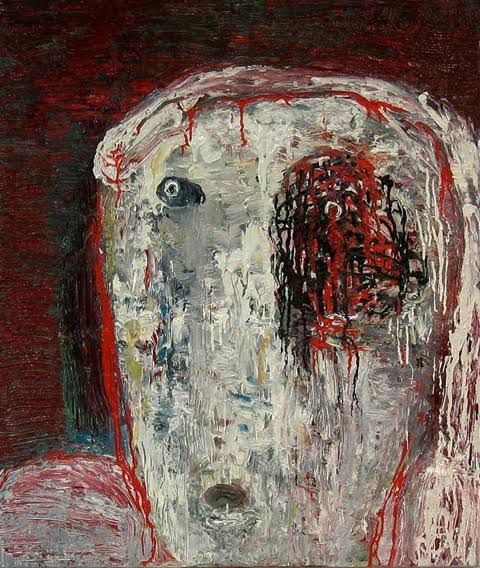
Self-Portrait 59. 36 x 30″. Oil on wood. 2006.
And then there is Brenda Goodman, whose paintings compromise the other five pieces in the show. If Gilmore plays at what goes onto or through a painting, Goodman shows us what gets pulled out of them, like entrails. The paintings are a kind of haruspex, as Goodman herself has stated in a number of interviews; her process is one of constant response to the interior world of the image and her own psyche, investigating how those competing needs manifest compositionally and texturally.
When we break down the paintings, three breeds become evident under a broader umbrella of figurative painting: two self-portraits that take the figure as their main compositional device, two self-portraits that situate a figure in a larger space, and one ambiguously figurative piece that flirts heavily with abstraction.
Of the first category, Self-Portrait 2 and Self-Portrait 59 are both cropped to an intense focus on the figure. Goodman often professes to the therapeutic effect of painting and calls this series of self-portraits in particular a means of confronting her own weight. Here, that weight is articulated not so much through shape as through the weight of the paint itself. Self-Portrait 2 is a mass of texture as the figure stuffs her face full of decadent browns and yellows. Self-Portrait 59 crops close on the face, where a red, black, and white palette inevitably conjures Guston, though these eyes are much smaller than any of his figures’, and more haunting. Blackened and bloody, seemingly gouged by the wooden end of a brush, the paint is almost meant to be felt, brutally, rather than seen, and in this sense a tactile relationship to Gilmore’s work builds.
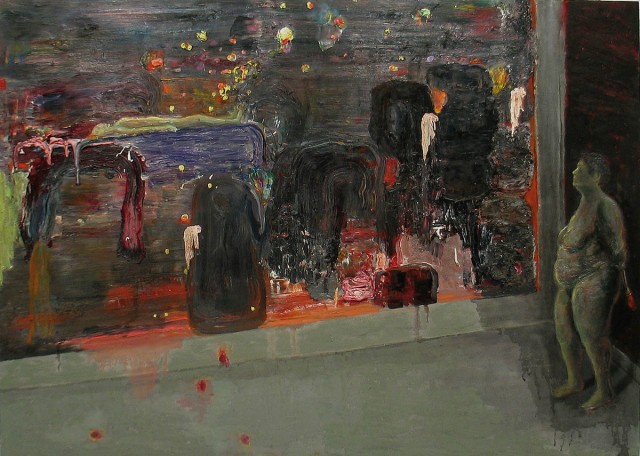
Self-Portrait 13. 36 x 50″. Oil on wood. 2005.
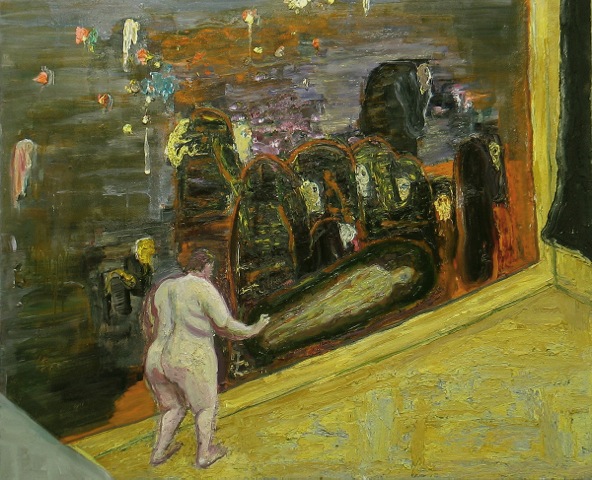
Self-Portrait 14. 32 x 39. Oil on wood. 2005.
In the two paintings of a larger space, Self-Portrait 13 and Self-Portrait 14, the artist herself is at work in her studio. Each time she is dwarfed by an enormous canvas, paint brush in hand, hard at work or in contemplation, completely naked. The obvious read has Goodman bare in her painting, vulnerable to them, or in a power struggle. The perspectival angling of the floor, diagonally raised as it is, pulls the architectural space toward an abstract composition, but Goodman’s rendered figure presents a full-scale shift back toward illusion. That play creates a tension that informs the work as a whole and seems to invite a closer consideration of the relationship between the body and the painting. Indeed, the paint of the figure and the paint of the large canvas the figure is engaging are similarly worked, separate from the architectural space of the painting, which is itself broader and monotone. In both painting and figure, Goodman’s handling is compacted and labored such that it links paint to flesh, as if animated by the same life force.
The content of the paintings-within-the-paintings provides even more food for thought. In Self-Portrait 13, artist in profile and to the side, a series of semi-rectangular arches dominates her composition. It is flush with activity, muted color interrupted by moments of intensely saturated reds and blues, and complex in a way decidedly different from the work as a whole, which, despite the busy piece it contains, is rather stark. That somber atmosphere is in keeping with its general subject: the painter in her studio, self-reflective, penitent. Of course, Goodman makes clear the dynamism beneath the surface of that lonely activity by placing this smaller painting within the framework of the larger piece, a complex psychology that becomes even more dramatic once we recognize a greenish figure, easily a corpse, in repose on a blue bed in the upper left. That corpse at once reframes the other shapes of the painting as figures in a kind of procession – we can even make out what might be small heads of thick, dripping white. Are these two paintings a burial? Indeed, the corpse seems to find a tomb as soon as Self-Portrait 14. Then who does this corpse represent?
The easiest answer is the painter herself, perhaps someone that Goodman seeks to put to rest; in interviews she speaks of wrestling with her weight and with the distance she kept from those close to her. For me, it is a laying-to-rest of the anxiety of painting. To see a painter still in her prime forging on after years dedicated to a medium declared dead many times over, and still making it pulse with life, is to see a declaration of the living.
A final painting, Ah, Her Red Hair, the most recent of the show, stands on its own as a step into figurative abstraction. While all the pieces of the show tie the figure to the realm of paint, this piece does it, in my opinion, the most integrally.
Goodman describes the process for the new series of paintings to which this one belongs as a conjuring of the divine, guided by an instinct and painterly intuition that comes of years of learning what to fight for in a painting and what to excise for the better good. “The only time painting is difficult,” she says in a 2014 conversation with Brett Baker for Painters’ Table, ” is when my will and ego are holding onto something in the painting that is blocking its competition. Then I have to let go and surrender, and once I do, the painting finishes itself. But the abyss is very dark until the letting go begins.”
As Goodman describes it, her shapes ostensibly grow out of the field of paint, emerging as if from the canvas itself. Her job is to decide whether to pull them into focus or obliterate them. Somehow this way of painting lends finality to the work that is distinctly Goodman’s. Ah, Her Red Hair is difficult to imagine any other way than it is, structure tectonically set, like plates locking together, and organic, igneous injections for figures.
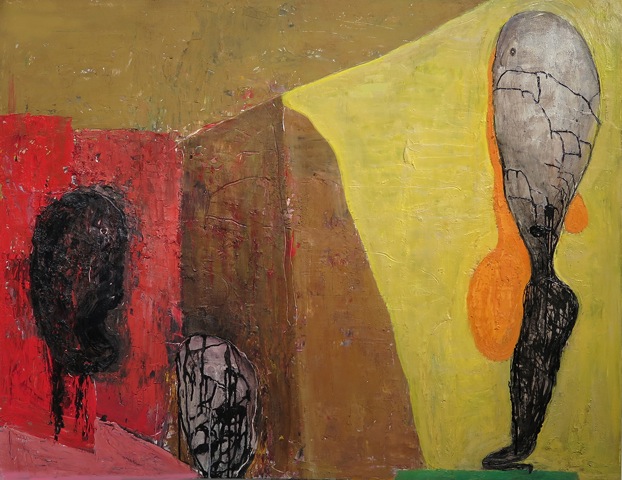
Ah, Her Red Hair. 40 x 51.5″. Oil on wood. 2014.
The piece also complicates the narrative of the show because it is not explicitly, like her others, a self-portrait. Goodman’s form does not populate the space of the painting, at least not in a way that is named by its title. In process and in form, it others Goodman into an active spectator. The figures in the painting are far less human, hardly recognizable as any particular person, yet they remain incredibly specific. A narrative, though less decipherable than in other pieces, is implicit, perhaps due to the title – Ah, Her Red Hair, is an exhale of desire. We could never fool ourselves into thinking that this painting isn’t deeply personal, the result of muscular self-reflection. And with Goodman, her own suffering is so very often in play; “Ah, Her Red Hair,” a sigh, suggests the bittersweetness of love lost or unrequited.
Indeed, Goodman does not shy away from narrative here or in any other paintings. Some action is always implicit. Smart curating puts that narrative action on an arch through a range of work spanning decades – from the body, to the body of the painting, to the body rapt in abstract form. The shift with Ah, Her Red Hair is clear in that Goodman no longer needs to insert her body literally because now it happens inherently, her interiority made physical. And because of that shift, the work is even more her own, even more about her.
If there is an incontestable current running through this show, it is women as a force, in paint. Gilmore, a veritable steamroller, plays in here-to-there, reducing narrative to its essentials – movement, catharsis – while toying with the gendered rhetoric and traditions of the canon of painting. Goodman feels the medium with her hands and gives us a tactile experience that pulls us into her deeply intimate journey. Power, skill, and knowing-when-to-let-go result in paintings that guide us through her life while reaffirming the clairvoyant power of an ancient medium.
In the end, Trembling Halves is this: two women artists, in an intimately shared space, together with dominating works – specifically ones that bring their own bodies to the fore. And make no mistake, this is as much a show about the artists as individuals as it is any painting conventions or gender politics. If we leave with awareness of just one thing – from Goodman whose canvases are worked until completion glows from them, from Gilmore whose steady and unyielding advance breaks through everything in her path – it’s that these artists bare all of themselves, working to the bone, and that in doing so they are phenomenal. Because like all other phenomenal women artists who make a name for themselves, they know this outright: good work is hard work, gotten done.
– Todd Stong




